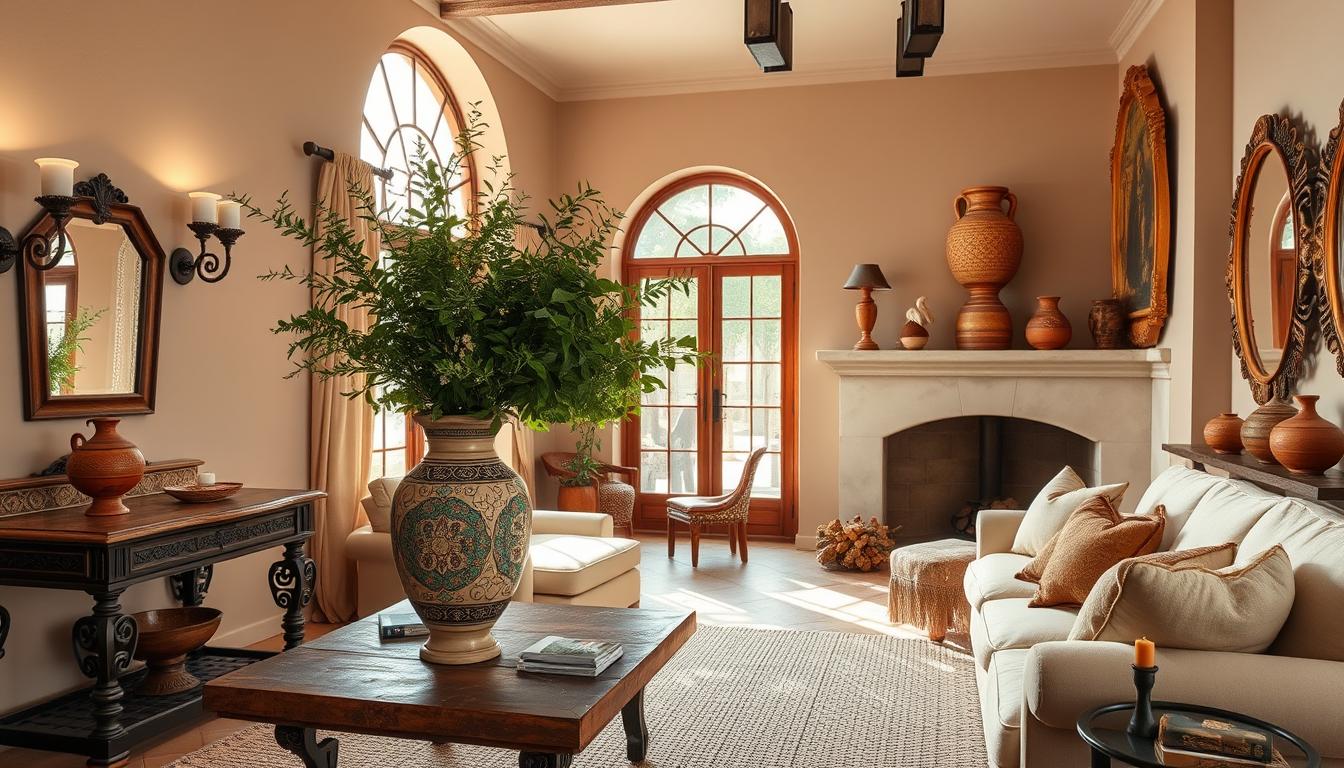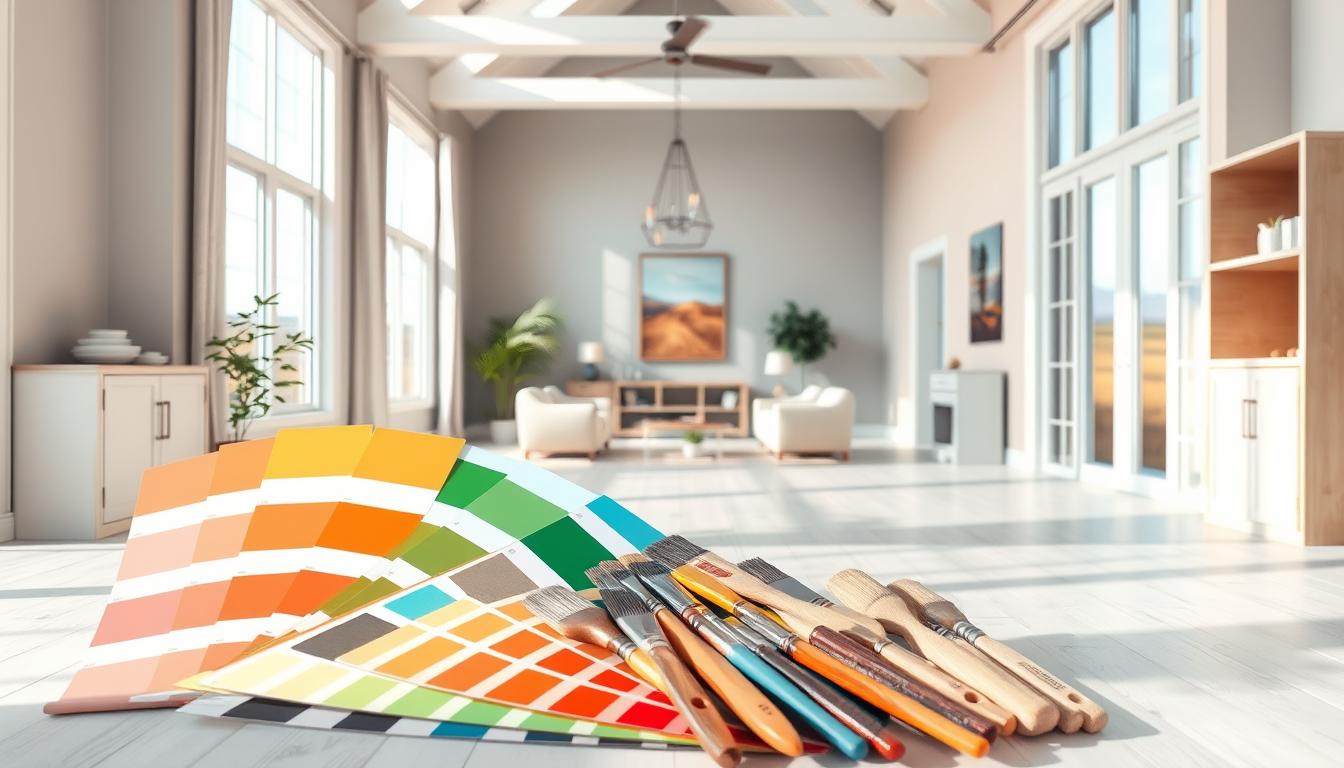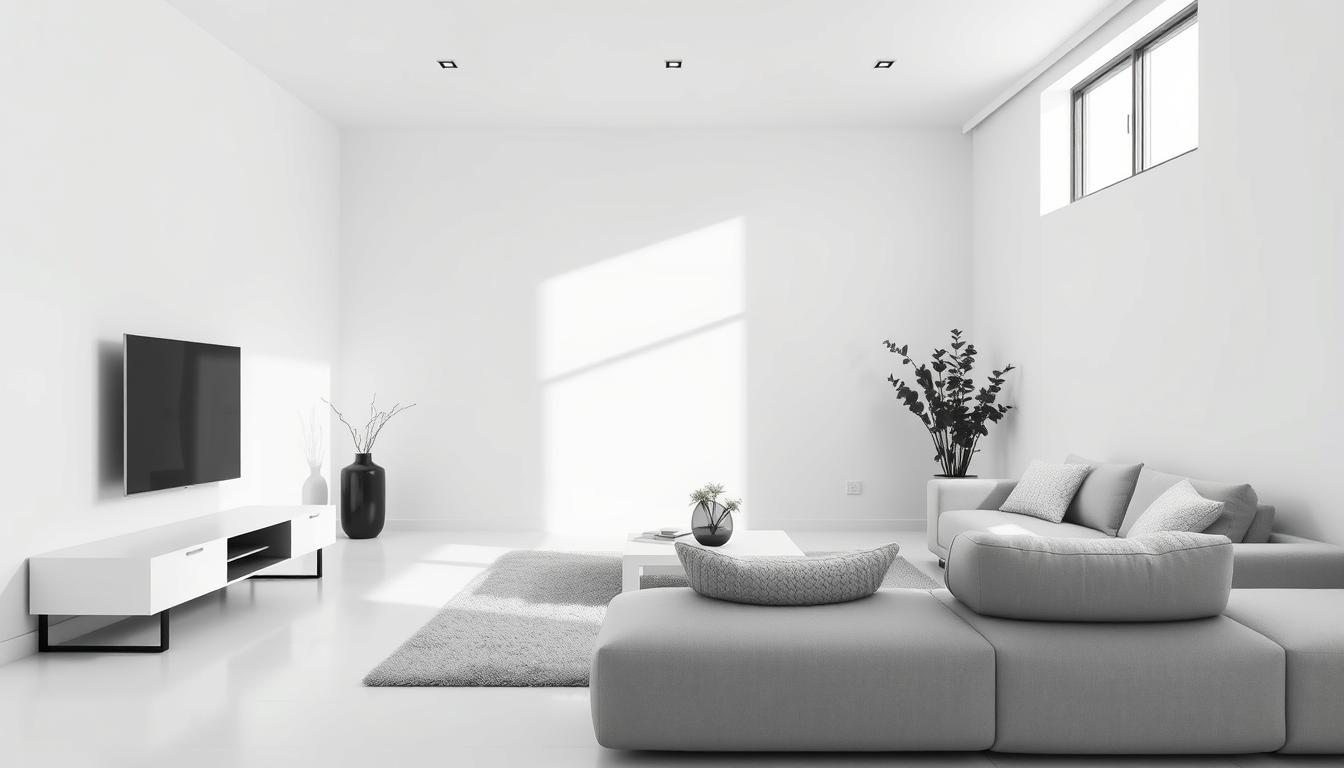The Mediterranean-style decor has won the hearts of homeowners all over the world. It takes them to the sunny coasts of the Mediterranean. This timeless look has been a favorite in interior design for centuries. It has influenced many cultures and architectural styles.
We’ll show you how to create a beautiful Mediterranean-inspired interior. It will be warm and elegant. We’ll talk about picking the right colors and adding architectural touches. These are key to this classic style.
Whether you’re redoing your whole home or just want a Mediterranean vibe, we’ve got you covered.
Key Takeaways
- Discover the key elements that define Mediterranean-style decor
- Learn how to choose a warm and inviting color palette
- Explore ways to incorporate architectural features into your design
- Find out how to add Mediterranean flair to your existing decor
- Get tips on renovating your entire home with a Mediterranean twist
Understanding Mediterranean Home Interior Design
Mediterranean interior design is more than a style; it’s an experience. It captures the warmth and elegance of the Mediterranean lifestyle. This design is rooted in the cultural heritage of the Mediterranean Sea’s regions.
The Origins of Mediterranean Design
The Mediterranean design style is inspired by Greek, Italian, and Spanish cultures. These cultures have woven their history and traditions into Mediterranean interior design. This creates a rich tapestry of elements.
Mediterranean homes were built to handle the warm climate. They have thick walls, large windows, and outdoor spaces. These features provide comfort and connect people to nature.
Key Characteristics of the Style
Mediterranean home interior design is known for warm, inviting colors. It combines traditional and natural materials. Terracotta tiles, wooden beams, and ceramics add to the cozy feel.
A big part of Mediterranean interiors is natural light. Large windows and outdoor courtyards make the inside and outside feel connected. This creates a seamless transition.
When renovating a mediterranean home, consider the color palette. Earthy tones like terracotta reds and sky blues are common. These colors reflect the Mediterranean’s natural beauty and create a welcoming atmosphere.
To bring a mediterranean color palette into your home, use natural materials and decorative accents. Thoughtful color choices can make your space feel authentic and inviting.
Color Palettes for Mediterranean Interiors
A well-chosen color palette is key in Mediterranean interior design. It shows the warmth and hospitality of the Mediterranean culture. The right colors can make you feel like you’re in the Mediterranean, bringing warmth and welcome to your home.
Warm Earthy Tones
Warm earthy tones are a big part of Mediterranean design. These colors, like terracotta and sun-baked soil, are at the heart of the Mediterranean color palette. Shades of terra cotta, sienna, and golden brown bring the warmth of the Mediterranean to your home.
Cool Ocean-Inspired Shades
Cool ocean-inspired shades add a refreshing touch to Mediterranean interiors. Blues and greens, like the sea and sky, offer a calming contrast to the earthy tones. These colors can be used in furniture, textiles, and decor to balance the look. For more inspiration, check out our guide on Spanish home interior design.
Accent Colors for Mediterranean Spaces
Accent colors add depth and personality to your Mediterranean space. Vibrant hues like turquoise, yellow, and orange can be used in decorative items, textiles, or artwork. They add a pop of color and create visual interest. These colors help tie together the warm earthy tones and cool ocean-inspired shades, making your space inviting.
By mixing warm earthy tones, cool ocean-inspired shades, and accent colors, you can create a unique Mediterranean color palette. This thoughtful approach to color selection will help you achieve a harmonious and inviting Mediterranean-style home interior.
Furniture Choices for a Mediterranean Vibe
Furniture is key in creating a Mediterranean look. It focuses on natural materials and comfort. Choosing the right furniture makes your home feel welcoming and beautiful.
Selecting Natural Materials
The Mediterranean style loves natural materials like wood, wicker, and stone. These add warmth and authenticity. Look for furniture made from:
- Reclaimed wood for its rustic charm and sustainability.
- Wicker and rattan for their natural, earthy feel.
- Stone and marble for their elegance and durability.
Emphasizing Comfort and Functionality
Mediterranean homes are meant to be enjoyed. So, comfort and function are important. Choose plush sofas and armchairs for comfort. Make sure your rooms are laid out well for easy movement.
Here are some tips for comfort and function:
- Choose multi-functional pieces, like storage ottomans or coffee tables with storage.
- Use layered lighting for a warm, inviting atmosphere.
- Opt for furniture with clean lines and minimal ornamentation for openness.
By focusing on natural materials and comfort, you can create a beautiful Mediterranean home. This approach ensures your home is both inviting and stylish.
Incorporating Textiles in Mediterranean Design
Textiles are key in Mediterranean interior design, adding warmth and character. They can make a room feel more inviting and real.
In Mediterranean design, the right textiles are as important as the architecture. Traditional fabrics like linen, cotton, and wool are favorites. They’re known for their natural beauty and lasting quality.
Traditional Fabrics to Consider
Mediterranean interiors often use natural fabrics for texture and depth. Some top choices include:
- Linen: It’s breathable and light, great for warm places.
- Cotton: Versatile, cotton works well in many ways, like bedding and upholstery.
- Wool: It brings warmth and coziness, perfect for cooler times or places.
These fabrics can be used in many ways, like for upholstery, drapery, or throw blankets. They add layers and interest to a room.
Layering Textures for Depth
Layering different textures is crucial for a Mediterranean-inspired space. Mixing fabrics creates a deep, inviting look. It feels cozy and welcoming.
| Texture | Examples | Effect |
|---|---|---|
| Smooth | Linen, Cotton | Creates a calm and serene feel |
| Rough | Wool, Jute | Brings warmth and coziness |
| Patterned | Kilim, Moroccan Tiles | Brings visual interest and cultural flair |
Using a mix of these textures can make your home look visually appealing and truly Mediterranean.
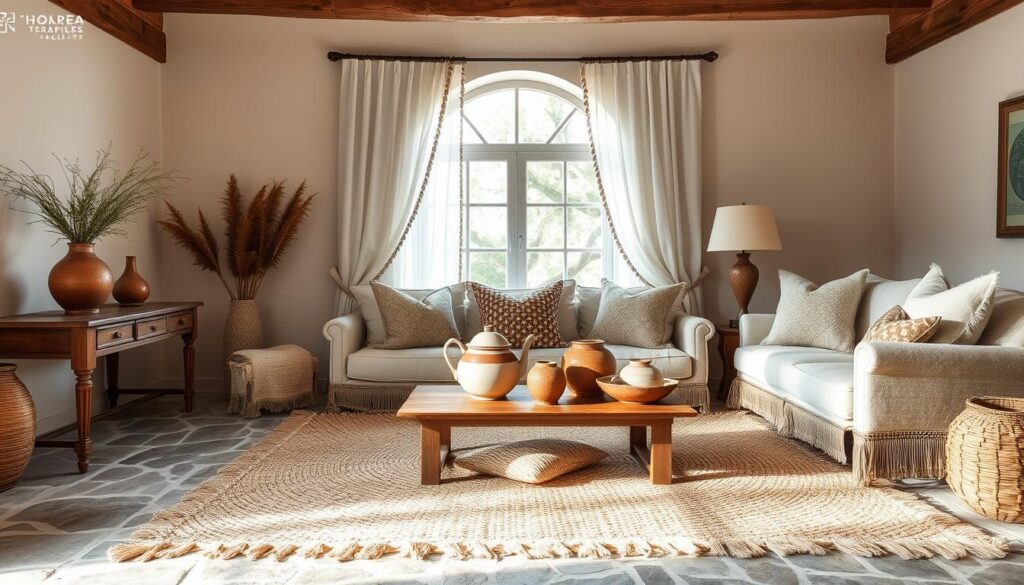
Flooring Options for Authenticity
The right flooring can make a Mediterranean home feel real. It’s not just about looks; it’s also about lasting quality and comfort. In Mediterranean design, floors show the region’s rich culture and its bond with nature.
Popular Choices: Tile vs. Wood
In Mediterranean home design, tile and wood floors are top picks. Tile flooring, like terracotta and ceramic, is tough and stylish. It’s great for wet areas like kitchens and bathrooms.
Wood flooring makes rooms feel warm and welcoming. It’s perfect for adding a cozy touch to any space.
Tile floors are classic in Mediterranean decor, offering a timeless look. Wood floors, though natural, add a unique vibe. They can be enhanced with rugs and decor.
Tips for Choosing the Right Flooring
Choosing the right flooring for your Mediterranean home is key. First, think about the room’s use and how much it’s walked on. For busy spots, tile is a good pick for its durability. For cozy areas, like bedrooms, wood might be better.
- Think about the flooring’s color and texture and how it will match the room’s design.
- Consider how easy the flooring is to clean and maintain.
- Remember the cost and make sure it fits your budget.
By thinking about these points, you can pick flooring that boosts your Mediterranean home’s look and meets your needs.
Architectural Elements of Mediterranean Homes
Mediterranean homes have unique architectural elements that define their charm. These features add visual interest and blend indoor and outdoor spaces. Let’s look at how these elements enhance the look and function of these homes.
Arches and Vaulted Ceilings
Arches and vaulted ceilings are key in Mediterranean architecture. They bring elegance to both inside and outside. Arches frame doorways and windows, creating a smooth flow. Vaulted ceilings make rooms feel bigger and more open.
When adding these features to your Mediterranean style living room or home, think about structure and design.
Importance of Outdoor Spaces
Outdoor areas are vital in Mediterranean homes, blending with indoor spaces. They connect us with nature and offer places for relaxation and fun. With lush landscaping and cozy seating, these areas become welcoming.
For those doing a Mediterranean home renovation, adding outdoor spaces can greatly improve living.
| Element | Description | Benefit |
|---|---|---|
| Arches | Curved structures used in doorways and passageways | Adds elegance and creates a sense of continuity |
| Vaulted Ceilings | High ceilings that follow the shape of the roof | Creates a sense of openness and spaciousness |
| Outdoor Spaces | Patios, courtyards, and gardens | Fosters connection with nature and expands living areas |
Lighting in Mediterranean Interiors
In Mediterranean interior design, lighting is key to warmth and elegance. It brings out the beauty of Mediterranean furniture design and matches the mediterranean color palette.
To get the Mediterranean feel right, balance natural and artificial light. We’ll look at how to use natural light and pick the right fixtures for your home.
Natural Light Maximization
Getting lots of natural light is crucial in Mediterranean design. Big windows, skylights, and sliding glass doors let in plenty of light. Use sheer curtains or blinds to filter sunlight and keep privacy.
Also, place mirrors by windows to bounce light into rooms. This makes spaces brighter and more welcoming. It also adds elegance.
Choosing Appropriate Fixtures
Choosing the right lighting for a Mediterranean home is important. Look for fixtures made from natural materials like wrought iron, bronze, or copper. They bring authenticity to your space.
Use pendant lights, chandeliers, or sconces with detailed designs. These match the ornate details of Mediterranean architecture. For outdoor areas, lantern-style lights make patios and courtyards more inviting.
By combining natural light with the right fixtures, you can make your Mediterranean interior warm, inviting, and stylish.
Accessorizing Your Mediterranean Home
The beauty of a Mediterranean home is not just in its architecture. It’s also in the personal touches and decorative elements that make it feel like home.
Accessories are key to making your Mediterranean-style home warm and inviting. Let’s look at how to add art, decor, and lush greenery to your space.
Art and Decor Ideas
The right art and decor can transform your Mediterranean home. Look for pieces that show off the region’s rich culture.
- Use vibrant ceramics and pottery to add color and texture to your shelves and tables.
- Hang woven textiles, such as kilim or Moroccan rugs, on walls to create a cozy, eclectic atmosphere.
- Incorporate metalwork, like wrought iron or copper pieces, to add a touch of Mediterranean flair.
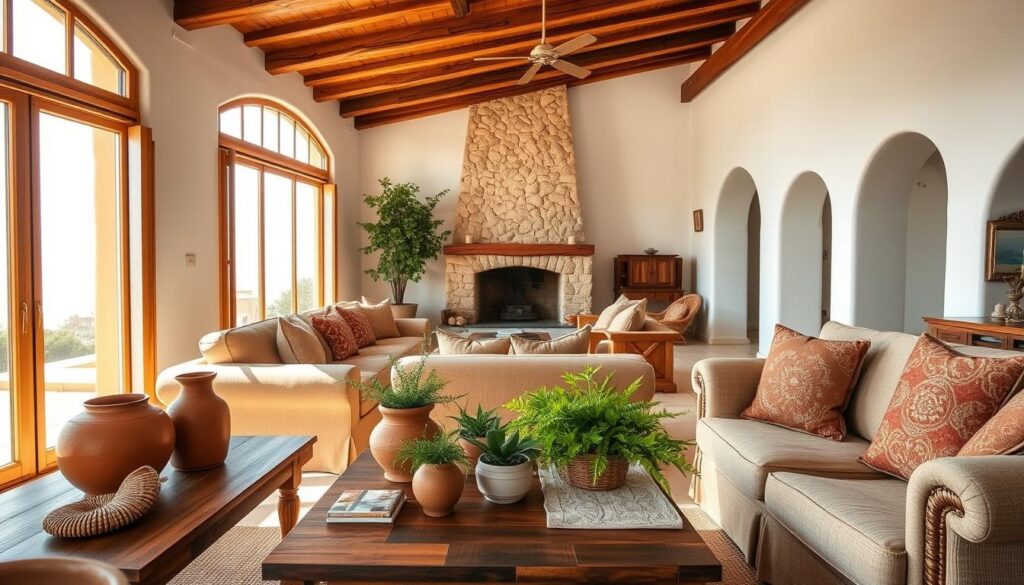
Incorporating Plant Life
Adding plant life is a great way to bring Mediterranean vibes into your home. The right plants can make your space feel lush and green.
Some excellent options for Mediterranean-inspired plant life include:
- Olive trees, which are symbolic of the Mediterranean region and can be grown indoors or outdoors.
- Lavender, which adds a fragrant touch and beautiful purple blooms.
- Bougainvillea, a flowering vine that thrives in warm climates and adds vibrant color.
By adding art, decor, and plant life to your Mediterranean home, you can create a warm and inviting space. It will truly reflect your personal style.
Outdoor Living and Its Significance
Mediterranean-style homes focus on outdoor living. Patios and gardens are key parts of the home. They make the home look better and offer places for fun and rest.
Outdoor spaces in these homes mix indoors and outdoors smoothly. They use the same materials and colors inside and outside. This makes the transition between areas feel natural.
Designing Inviting Patios
A great patio is key for Mediterranean outdoor living. To make one, add comfy seats, soft lighting, and decor that shows the Mediterranean style.
- Choose natural materials like stone, wood, and wrought iron for furniture and decor.
- Add green plants and colorful flowers for texture and color.
- Put in heaters or coolers to use the patio all year.
Elements of Mediterranean Gardens
Mediterranean gardens use plants that don’t need much water, terracotta pots, and stone paths. These features make the garden look good and feel peaceful.
| Element | Description | Benefits |
|---|---|---|
| Drought-resistant plants | Plants like succulents and lavender that thrive in dry conditions. | Low maintenance, water-efficient. |
| Terracotta pots | Earthenware pots used for planting flowers and herbs. | Adds a rustic, Mediterranean charm. |
| Rustic stone pathways | Pathways made from natural stone, often irregularly shaped. | Creates a sense of history and texture. |
By adding these features, homeowners can make a beautiful and useful outdoor space. It’s perfect for relaxing and having fun.
Balancing Modern Amenities with Tradition
Mediterranean interior design brings warmth and character. It’s key to balance old traditions with new comforts. This mix of rich textures, bright colors, and cozy spaces makes a home unique and inviting.
Merging Old-World Charm with Contemporary Style
To blend old charm with new style, start by picking what you love from Mediterranean design. Look for arched doorways, terra cotta tiles, or wrought iron accents. Then, add modern touches that match these features.
For example, use modern Mediterranean furniture design that keeps traditional materials but looks sleek. This can make your space better.
In a Mediterranean-inspired bedroom, mix a wooden bed frame with modern lights or simple decor. The goal is to make both old and new parts work together. This creates a welcoming and unified space.
Smart Home Technologies in Mediterranean Design
Adding smart home tech to Mediterranean design can make living better without losing its beauty. Features like smart thermostats and voice-controlled lighting systems boost comfort and function.
It’s important to add smart tech in a way that keeps the design looking good. For instance, smart lights can fit inside old fixtures. Smart thermostats can be hidden, so they don’t take away from the design.
By carefully combining traditional Mediterranean style with modern comforts and tech, we get a home that’s both stunning and practical. It offers the best of both worlds.
Tips for Creating a Cohesive Look
Creating a cohesive look is key to a successful Mediterranean-inspired home. We make sure indoor and outdoor spaces match. We also keep colors and textures the same throughout our decor.
Indoor-Outdoor Harmony
To blend indoor and outdoor spaces, we use the same design elements. For instance, we might use the same tile indoors and outdoors. Or, we might choose similar furniture for both areas. This creates a continuous feel, which is central to Mediterranean home design.
Consistent Color and Texture
Keeping colors and textures consistent is vital for a unified look. We pick a Mediterranean-inspired color palette, with warm earthy tones and cool ocean shades. We use these colors everywhere in the home.
We also add natural textures like wood, stone, and terracotta. These add depth and interest to our decor.
By following these tips, we can make a beautiful, cohesive Mediterranean-inspired home. It will be welcoming and true to the Mediterranean style.

